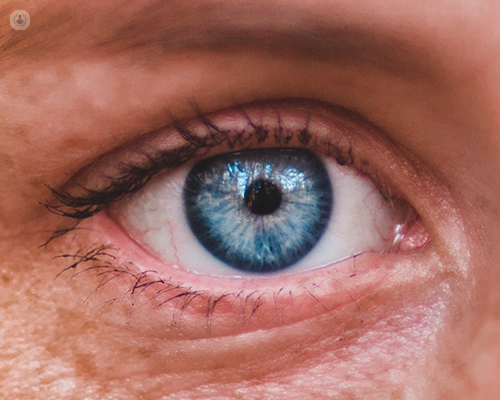wet and dry ARMD (age-related macular degeneration) treatment
Autore:Age-related macular degeneration (ARMD) can be classed as wet or dry, with dry ARMD being the most common. Learn about ARMD from Mr Maan Kasmiya, a consultant ophthalmologist who has spent many years treating the condition.

At what age does age-related macular degeneration start?
Age-related macular degeneration (ARMD) is a condition which affects the central retina area in the back of the eye, which is called the macula. It happens as part of the ageing process and leads to the eventual loss of central vision. However, peripheral vision is most often still normal.
It usually affects patients who are 55 years old and older , but it can still happen earlier in age, especially if there is a family history of ARMD.
Are there types of ARMD?
ARMD has two types:
- Dry (non-exudative) ARMD: This type accounts for around 85-90 per cent of all cases. It develops slowly as parts of the macula get thinner with age and tiny clumps of a protein called Drusen appear. In some cases, this can develop into geographic atrophy (GA), an advanced form of ARMD.
- Wet (exudative) ARMD: This type accounts for around 10-15 per cent of cases and appears suddenly, leading to severe central loss of vision. This form is less common but much more serious. It happens when abnormal blood vessels grow under the retina and leak blood or other fluids, causing scarring of the macula.
When is an eye check-up recommended?
Many people don’t realise they have ARMD until their vision is very blurry. This is why it is important to have regular visits to an ophthalmologist who can look for early signs of ARMD before you have any vision problems.
Can the dry type develop into the wet type?
Yes, dry ARMD can develop into wet ARMD in around 10-15 per cent of cases.
What treatments are available?
Wet ARMD
Wet ARMD is widely treatable with a course of Anti-VEGF medication, which is delivered through a small injection inside the eyeball. This is viewed as the gold standard treatment. Studies have shown that around 90 per cent of treated wet ARMD have stabilised vision. Furthermore, 30 per cent showed an improvement in their vision with the treatment.
There is a new way to deliver the injection called the port delivery system (PDS) which is an intravitreal reservoir implant placed as a one-time surgical procedure. The device, roughly the size of a grain of rice, is loaded and holds a small volume of a highly concentrated drug that is slowly released over a four to six-month period. The device can then be refilled in the ophthalmologist’s office with a custom needle that is part of the drug/device combination system.
Dry ARMD
Dry ARMD treatment is limited at this stage, but prevention plays an important role. There are risk factors that can be modified through lifestyle including:
- Quitting smoking
- Losing weight to reduce BMI (body mass index)
- Treatment of hypertension (high blood pressure)
There has been a large study, called the AREDS (Age-Related Eye Disease Study), that shows that antioxidant and mineral supplementation can reduce the risk of ARMD progressing if it’s in a moderate stage.
There are further ongoing clinical trials that are looking at possible new treatments for dry ARMD, including the use of small inhibitory RNA molecules, monoclonal antibodies, gene therapy, anti-inflammatory medications, antioxidants, and cell-based therapies.
Visit Mr Kasmiya’s profile to learn how you can benefit from his first-class ophthalmic services and arrange your online or face-to-face consultation.


